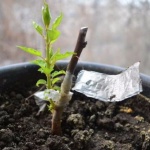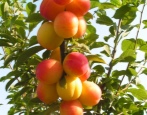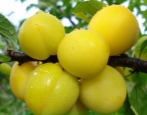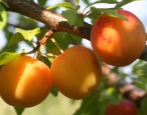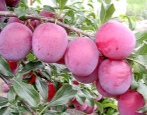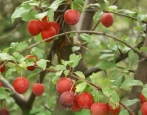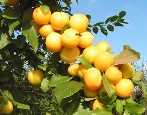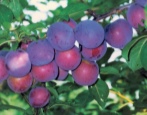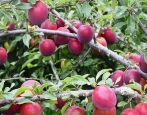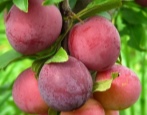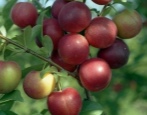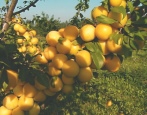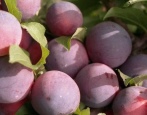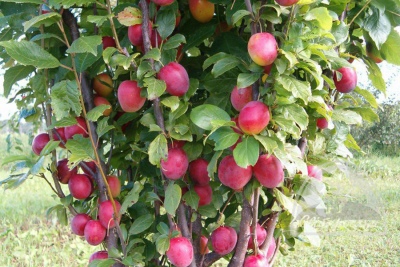
- Growth type: medium-sized
- Ripening period: mid-late
- Self-fertility: self-infertile
- Fruit size: large
- Yield: high
- Appointment: for canning, for fresh consumption
- Transportability: good
- Fruit weight, g: 40
- Fruit shape: oval
- Fruit color: dark red, with a medium waxy bloom
Cherry plum is a southern plant inhabiting the gardens of central Russia and southern Siberia. The plant is distinguished by unpretentiousness in planting, ease of care, excellent fruiting. All this, and even more, can be said about the universal variety of cherry plum Kolonovidnaya.
The plant looks very attractive, gives tasty and fragrant fruits, which are eaten fresh, compotes, preserves, jams and jelly are cooked from them, and deep frozen. The berry is rich in vitamins, trace elements and other useful substances, has good transportability, so the culture can be grown on an industrial scale.
Breeding history
The homeland of the Column-shaped cherry plum is the Crimean Experimental Breeding Station of the V.I. N.I. Vavilov, where a team of breeders worked on obtaining a new variety under the leadership of Academician of the Russian Academy of Sciences, Professor G.V. Eremin. Columnar was approved for use in 2002.
Description of the variety
Medium-sized (up to 3 m) tree with a compact, columnar and sparse crown of no more than 1.2–2 meters in volume, without pronounced skeletal branches, evenly covered with fruits throughout its volume. The strength of growth depends on the rootstock - it is its vigor that is capable of giving the cherry plum the opportunity to reach its maximum height.
The advantages of the variety:
- compactness;
- early maturity;
- unpretentiousness;
- strong immunity;
- high productivity;
- tasty and fragrant fruits;
- resistance to frost, drought, strong winds.
During and after transportation, the fruits retain their beauty, integrity, freshness, taste and aroma. Another feature of the variety is a long dormant period, the flowering phase occurs later than other varieties of cherry plum.
Fruit characteristics
Large (up to 40 g) oval fruits with a dense elastic skin, not prone to cracking. The ripe fruit is colored in a dark red palette with a bluish bloom of prune. A medium-sized bone is quite easily separated from the pulp. With good storage organization, the keeping quality of fruits reaches three months.
Taste qualities
The beautiful pulp of an intense pink hue has a delicate aroma, medium density and a sweet dessert taste with a touch of sourness.
Ripening and fruiting
The early-fruiting variety belongs to the mid-late ripening category - the harvest is harvested at the end of June in the middle lane, a little earlier in the southern regions. Regular fruiting occurs in the third year after budding.
Yield
Columnar cherry plum gives high yields - up to 40 kilograms per tree.
Growing regions
The variety was bred and adapted for the Crimean climate, but the endurance of the plant makes it possible to grow a crop in the middle lane and in South-West Siberia, for example, in Altai.
Self-fertility and the need for pollinators
The variety is self-fertile, the presence of a pollinator in the neighborhood (Kubanskaya Kometa) guarantees high yields.
Growing and caring
Cherry plum is a product of southern selection, therefore, it needs constant lighting. The ideal planting site is southern slopes and sunny areas with fertile soil. The plant does not tolerate wetlands and the proximity of groundwater. If there is no such place, it is possible to form an artificial embankment 40-50 cm high and up to one and a half meters in diameter.
As for the soil, for cherry plum, breathable fertile soils with a rich filling of humus and microelements are preferable. The acidity level should be neutral. Sour soil is subject to mandatory deoxidation with dolomite flour, chalk, lime, wood ash - 2 kg per 5 sq. m. If the landing site contains heavy clay soil, then it is taken out when organizing the landing pit and replaced with the necessary composition prepared from an equal amount:
- river sand;
- leafy land;
- humus or compost;
- the upper fertile layer.
Planting time is standard - spring or autumn, the choice is individual, but an experienced gardener always prefers the autumn season. Spring terms - from April 18 to May 9, autumn - from August 25 to October 10. The numbers can be adjusted based on local climatic conditions, but in any case, the plant needs at least a month to adapt.
The optimal size of the planting pit is 50x50x60 cm. A 10-cm drainage layer is required at the bottom, and a support for the young stem is immediately installed. The remaining space is filled by? prepared soil mixture, set the seedling and cover with the remaining earth. When planting, you need to monitor the root collar, it should be flush with the surface. The trunk circle is abundantly (20 l) watered with warm water. After the moisture is absorbed, mulch with a 5-centimeter layer of peat or straw.
Fertilization in subsequent years is carried out three times per season. In the spring cherry plum needs nitrogen fertilizers to build up green mass. Before flowering, the tree is fed with an infusion of liquid mullein (1: 10) after abundant watering. In autumn, near-stem circles are fertilized with complex mineral compositions for fruit and berry plants, for example, "Kemira Autumn". An adult tree needs calcium, therefore, in May, June, watering is carried out with the addition of calcium chloride - 3 tbsp. l. for 10 liters of water.
Watering is carried out 2 times a month at the rate of 30 liters under the root. For mature trees, irrigation is reduced to 1 time per month, but the rate is increased to 60 liters for each trunk. The plant does not need formative pruning; in the spring, its sanitary version is carried out to remove dry, damaged, weak shoots.
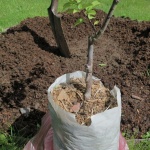
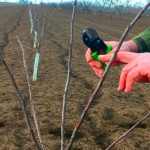
Disease and pest resistance
The variety has a high resistance to diseases and pests, but still does not have 100% protection against cherry plum aphid, brown fruit mite, leafworm and false shield. Preventive treatments with insecticides and fungicides should be mandatory. The thin bark is a real treat for rodents in the winter, so the trunks also need special seasonal protection.

Requirements for soil and climatic conditions
Columnar cherry plum is highly winter-hardy and can withstand temperatures as low as -28ºC.Even with a slight freezing, the plant is capable of quick rehabilitation during one growing season.
